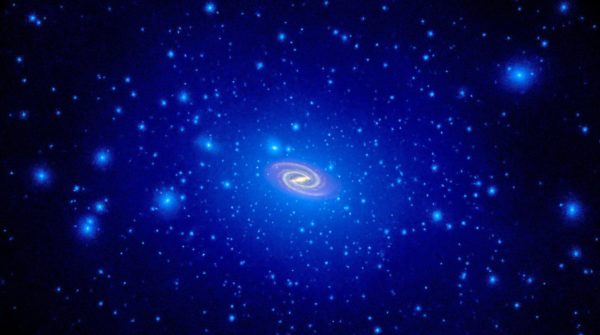"Nothing in the standard cosmological model predicts this, and it is almost impossible to imagine how that model could be modified to explain it, without discarding the dark matter hypothesis completely." -David Merritt
Dark matter is a hugely successful theory for explaining a whole slew of observations about the Universe. Just by adding this one ingredient to the mix, we can successfully simulate and reproduce the large-scale structure, CMB fluctuations, galaxy clustering and cluster collision properties observed in our Universe. Without dark matter, there's no other way known to make the Universe work in line with what we see.
 A clumpy dark matter halo with varying densities and a very large, diffuse structure, as predicted by simulations, with the luminous part of the galaxy shown for scale. Image credit: NASA, ESA, and T. Brown and J. Tumlinson (STScI).
A clumpy dark matter halo with varying densities and a very large, diffuse structure, as predicted by simulations, with the luminous part of the galaxy shown for scale. Image credit: NASA, ESA, and T. Brown and J. Tumlinson (STScI).
And yet, if you go down to the small scales of individual galaxies, dark matter predicts a dark matter halo of a specific profile with specific rotation properties. When we look at the actual galaxies, those rotation properties don't match! Even worse, they appear to be correlated solely with the normal matter content of the galaxies, and have no dependence on whether the galaxy is rich-or-poor in dark matter.
 he correlation between gravitational acceleration (y-axis) and the normal, baryonic matter (x-axis) visible in an assembly of 153 galaxies. The blue points show each individual galaxy, while the red show binned data. Image credit: The Radial Acceleration Relation in Rotationally Supported Galaxies, Stacy McGaugh, Federico Lelli and Jim Schombert, 2016. From https://arxiv.org/pdf/1609.05917v1.pdf.
he correlation between gravitational acceleration (y-axis) and the normal, baryonic matter (x-axis) visible in an assembly of 153 galaxies. The blue points show each individual galaxy, while the red show binned data. Image credit: The Radial Acceleration Relation in Rotationally Supported Galaxies, Stacy McGaugh, Federico Lelli and Jim Schombert, 2016. From https://arxiv.org/pdf/1609.05917v1.pdf.

Looks like the universe has thrown us another curve ball. On the one hand, dark matter has been incredibly successful in explaining big cosmological questions and the evolution of structure on the size of galactic clusters and larger. Modified gravity theories such as MOND and TeVeS have not been able to satisfactorily explain these aspects of cosmology, at least not without resorting to some form of dark matter as well.
MOND can of course accommodate the new data from these observations because it is an empirically motivated theory sort of like Kepler's laws of planetary motion. What it doesn't seem to actually have is some kind of fundamental theory of gravitation that would do for it what Newtonian gravity did for Kepler's laws.
Frankly, I think that probably there is some sort of dark matter out there. And also we know general relativity also cannot be the final word on gravitation. The fact that it is incompatible with quantum mechanics all but assures us of this.
Ethan can you clarify something, does the statement that you only need to know the distribution of normal matter to predict the gravitational acceleration, imply (1) you don't need any DM in the interiors of galaxies there is enough normal matter to explain the rotation curve. or (2) It works if we assume some universal "ratio" of DM to baryonic matter?
And how does this square with Zwickys original observation about rotation curves?
This seems to be quite the curve ball throw at us.
@Omega Centauri #2: The issue here is just one of a tight correlation in a scatter plot.
With the conventional dark matter model, we measure a galaxy rotation curve, use that curve to infer (from simple Kepler/Newtonian equations) the gravitational mass distribution that holds the galaxy together. We separately use telescope observations to construct a distribution of visible mass. The difference between those two distributions is what we label "dark matter." What we've seen is that those distributions vary from galaxy to galaxy, and we also see that when we try to simulate how dark matter behaves (which is super successful for cosmological structure), then we _cannot_ reproduce those inferred single-galaxy distributions.
This new paper does something much simpler: It does the visible-mass observation, and computes the acceleration due to gravity from that mass at some distance from the center. Then it looks at the rotation curves and works out what the central acceleration must be to get the observed rotation speed at the same distance. If you plot those two calculations, for each galaxy, you get the third figure above: there's some universal _correlation_ between the two, that spans all kinds of different galaxy morphologies, including those for which we infer just "some" DM and those which are "mostly" DM. Instead of having seemingly unique visible-DM relationships, all these different galaxies seem to have some universal "gravity" behaviour which shows a non-linear relationship consistent with what MOND predicts.
Very interesting result, but it is not yet clear how to interpret it, or how to connect it to the precision large-scale structure.
Is Dark Matter a theory? At this point it is observational with just hypothetical rumblings and suppositions. There is no acceptance of just a general explanation of its mechanism.
Is MOND or TeVeS? As far as semantic niggling goes, this is pretty stale.